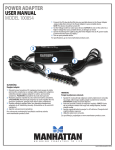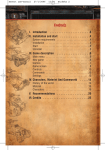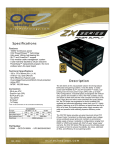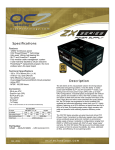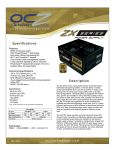Download Project Scan-a-Tron - Big Al`s Computers
Transcript
Project Scan-a-Tron By Allen C. Haid January, 2007 The “Scan-a-Tron” case mod project is the realization of an idea I had over a year ago. The original concept was to build a computer into an old HP ScanJet 6100C that I bought from a work auction for just a couple of bucks. I had the scanner taken apart within a day of bringing it home, but soon realized that it wasn’t going to be deep enough to accommodate modern CPU coolers and especially graphic cards or even a normal-sized PSU. So I put the scanner back together and let it sit in my workshop, collecting dust. Fast forward about eight months and I was now looking at an old HP Pavilion ze4145 laptop that was available to me since I had just given my wife a new replacement laptop for her birthday. This three-year old laptop wasn’t much use for anything more than browsing the Internet, so I figured this was my answer to the size issues of the original Scan-a-Tron concept. I could work around the space limitations after all. Figure 1 Like a new father, Allen is proud of Scan-a-Tron Scan-a-Tron was scheduled to be a holiday 2006 project, meaning I would have the parts on hand and do most of the build during the last week of December. This week has become my annual mod week, and as long as I prepare for the work ahead of me, I can usually get the job completed before New Year’s Eve is history - sort of a last hurrah to the current year. The first step in modding is to come up with a concept, and then try to visualize how it can all come together before you make the first cut. Drawings help with this task, and I had to diagram a few important steps along with taking some critical measurements. For one thing, I decided that Scan-a-Tron would be mounted in my work bench shelving unit (see figure 1). It was a tight fit, as I had only 0.5 inches total clearance on the sides. The Build Process Diagram on the next page provides the basic layout of the mod. 1 Project Scan-a-Tron By Allen C. Haid January, 2007 Build Process Diagram It’s a simple process, if you can visualize everything at one time! Custom laser-etched window made by Hyperkore Computers My donor laptop, an HP ze4145 The motherboard stays with the chassis No need for the old laptop display The scanner PSU is history My donor scanner, the HP ScanJet 6100C Cold cathodes on both sides, with the hardware mounted underneath Cold cathodes inside the cavity A USB 2.0 hub for external devices Measuring the old scanner glass that’s being replaced An HP USB 2.0 Cardbus adapter LEDs to be cut apart for the perimeter of the window Legend Item removed Item added A 60mm fan will suffice for cooling 2 Project Scan-a-Tron By Allen C. Haid January, 2007 The steps that follow a concept formulation basically depend on the skills of the case modder. First time modders should carefully review what must be disassembled, the placement of each additional component, measuring and writing down the sequence of installation. All donor parts, such as the scanner and laptop in the case of Scan-a-Tron, should be carefully disassembled without breaking parts that might be required later. This is an area where experience leads the more seasoned case modder to find the proper documentation that will aid in the disassembly process. Taking apart the old HP scanner was really a piece of cake. The top cover just came right off (it was designed to be removable by the scanner user), and after removing four screws in the top section, I had access to the interior (figure 2). I realized that I needed the heavy metal frame section at the rear of the scanner, as this was the support for the top section. I didn’t need those rails for the scan assembly, and I certainly didn’t need that power supply unit (PSU). Figure 2 The interior of the HP 6100C scanner After removing the unnecessary components, I was left with the scanner chassis as shown in figure 3. I was now visualizing different mounting options for the HP Pavilion ze4145 laptop that I had yet to disassemble. Would I have to remove the center section from the scanner chassis to make it deep enough for the laptop? Which way should I orient the laptop itself, profile or landscape? Because I had already considered my mounting options for the completed project, I knew that a landscape mounting for the laptop would be best, but now it was time to see how far I could disassemble the laptop and thus determine how thin it could be made. Height of the laptop mounting was my real enemy. 3 Project Scan-a-Tron By Allen C. Haid January, 2007 Figure 3 The scanner chassis after removing the unnecessary components Being a somewhat experienced case modder, I looked for documentation on the laptop. I went to the HP website and found a service manual. This is the exact type of documentation you need for laptop disassembly. I want to thank my friend Jim for suggesting that I look for this type of document – it probably saved me from breaking components when I tore the laptop apart. Speaking of the laptop, in figure 4 you can see what I was starting with. Figure 4 The donor laptop, an HP Pavilion ze4145 (2003 era) 4 Project Scan-a-Tron By Allen C. Haid January, 2007 The laptop disassembly went according to plan – meaning the steps in the HP service documentation! I knew I wasn’t going to use the laptop display. I already had a 17” LCD mounted to my workbench, and Scan-a-Tron would be connected to that when I was finished. But I certainly wasn’t going to break the laptop display, or even the keyboard. I gave them to my friend Jim for his use. You never know when you’ll need a certain part that can’t be easily purchased, so he now has a few extra parts that I didn’t need for this case mod project. In figure 5, you can see the laptop disassembled to just the motherboard / chassis components. These can be easily mounted within the scanner chassis while maintaining sufficient height clearance. Figure 5 The HP laptop chassis, aka "the guts" Before I go too much further, I should mention a very important step, one that I performed early in the modding process. If there are new parts or components that will be required, the time to order them is when you are trying to visualize the completed project. I knew I would require a few computer parts, such as a USB 2.0 hub and a USB 2.0 Cardbus adapter, but the big item was to be a laser-etched window to replace the scanner’s glass platen. I went with the boys at Hyperkore computers (http://www.hyperkore.com/etching/standard.html), as I have enjoyed dealing with Tommy and the other guys on previous orders. I submitted my custom “Big Al’s” logo design and asked Tommy to help me with the lettering layout. Tommy came up with a few ideas and in a few weeks I had my new custom laser-etched window (figure 6). This is the type of thing that can make a case mod really stand out from the competition! 5 Project Scan-a-Tron By Allen C. Haid January, 2007 Figure 6 My custom laser-etched window from Hyperkore Computers The new laser-etched window was sized to fit in the same mounting frame where the old HP glass platen was previously (figure 7). The window itself had to be ground along one edge to fit under the lip of the mounting frame, but this was no big deal with a Dremel tool. Illumination options for the scanner cavity would need to address my lighting options for this laser-etched window, and I decided to go with some LEDs mounted along two edges of the window (figure 8), and some cold cathode tubes mounted underneath the laptop chassis within the scanner cavity (figure 9). Figure 7 Using the original mounting frame for the new laser-etched window 6 Project Scan-a-Tron By Allen C. Haid January, 2007 Figure 8 Mounting LEDs along opposite edges of the laser-etched window Figure 9 Mounting 12" cold cathode tubes within the scanner cavity Getting back to the laptop itself, I had to make sure it was up to the task of running reliably within the scanner chassis. Cooling would be a very import concern, so I started by first removing the heatpipe CPU cooler from the AMD mobile Athlon XP CPU (figure 10) and cleaning up the thermal material before applying a fresh coat. You might have noticed the fan I installed (figure 9); this single fan, when combined with the CPU cooler, would be sufficient to cool this old laptop. This statement comes from my experience in building gaming machines and addressing the extreme cooling requirements of videocards running at their highest levels. 7 Project Scan-a-Tron By Allen C. Haid January, 2007 Figure 10 Removing the CPU cooler and applying fresh thermal interface material After some test fitting of the laptop chassis within the scanner cavity, it was time to start drilling holes (figure 11) and also time for something new – a hot glue gun. I had received a hot glue gun as a present perhaps 15 years ago and never used it. It was sitting on top of my shelving unit, out of arms reach. Now was the time to get it down and see how wonderful the gluing process can be. When I was all though with the glue gun, I figured that I had saved at least 2-3 hours of my time in not having to fabricate more mounting brackets or drilling more holes. Believe me, the hot glue gun won’t be sitting around for another 15 years! I used it for several items, including the USB 2.0 hub (figure 12). Figure 11 Mounting the laptop to the scanner cavity with three bolts 8 Project Scan-a-Tron By Allen C. Haid January, 2007 Figure 12 Mounting a USB 2.0 hub with the hot glue gun The final stages of the Scan-a-Tron case mod were focused on getting all the components to work together and also to get the case lighting worked out. There are lots of ways to add light to your cases, and I wanted to use both cold cathodes and LEDs. As it turned out, I found a new type of lighting device (figure 13) – Molex Lights (LEDs). These are made by Sunbeamtech, a company known for some unique items among case modders. Figure 13 Molex Lights are inserted into Molex power plugs 9 Project Scan-a-Tron By Allen C. Haid January, 2007 These new LED lights make it easy to add some lighting effects to your Molex power plugs, as shown in figure 14. I used three of these to bring a bit of green light into the scanner cavity, and that combined with the yellow cold cathode tubes (underneath the laptop chassis) and the red LEDs of the Hyperkore laser-etched window gave me the lighting effect I was looking for (figure 15). Figure 14 Molex lights work well when inserted into Molex power plugs Figure 15 The combined effect of LEDs and cold cathode lighting devices 10 Project Scan-a-Tron By Allen C. Haid January, 2007 At this point, I was almost finished. Scan-a-Tron was operational, and could be used “asis”, but I needed some place to put it. My original concept was to install this assembly into my work bench shelving unit (figure 16), and so I elected to undertake the task of cutting out a shelf, chiseling out part of another shelf (figure 17), and then painting the modded section (figure 18) of the shelving unit with black sheen spray paint to bring attention to Scan-a-Tron. The cutting part was very difficult because there isn’t much room to allow for the saw blade. I also had to stand on my work bench and squat down, never fun if you suffer from lower back issues like I do. Figure 16 The work bench shelving unit before modification Figure 17 Using a hammer and chisel to notch out the cable access hole 11 Project Scan-a-Tron By Allen C. Haid January, 2007 Figure 18 Painting the "modded" shelving unit Final assembly meant feeding the video, power, and other miscellaneous cables through the access hole and into Scan-a-Tron before installing the top section and hanging the scanner chassis onto two screws placed appropriately into 2 X 4 studs behind the storage room insulation. Figure 19 Scan-a-Tron mounted into the shelving unit And so there you have it. Scan-a-Tron isn’t a gaming machine, but it is a fine machine for browsing the Internet and downloading driver updates for my other projects while working in my storage room. It runs well, being quiet and stable. Overall, I’m happy! 12 Project Scan-a-Tron By Allen C. Haid January, 2007 13













